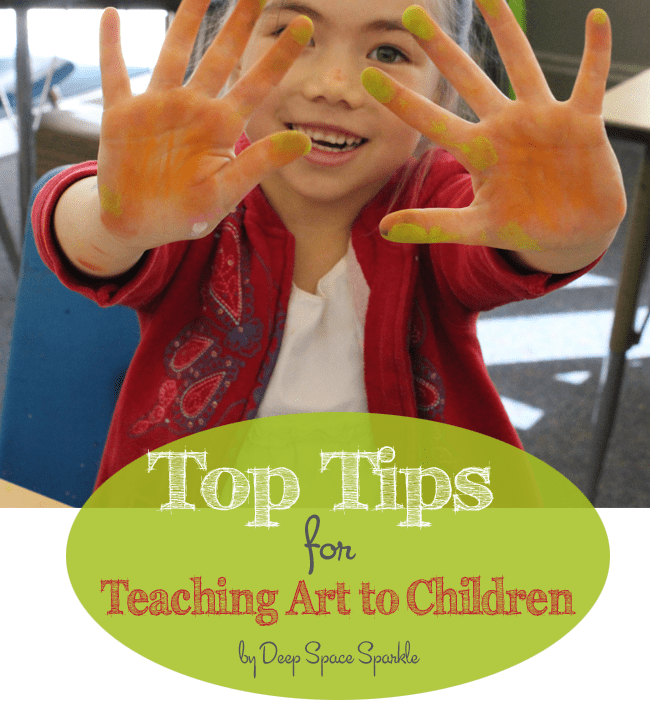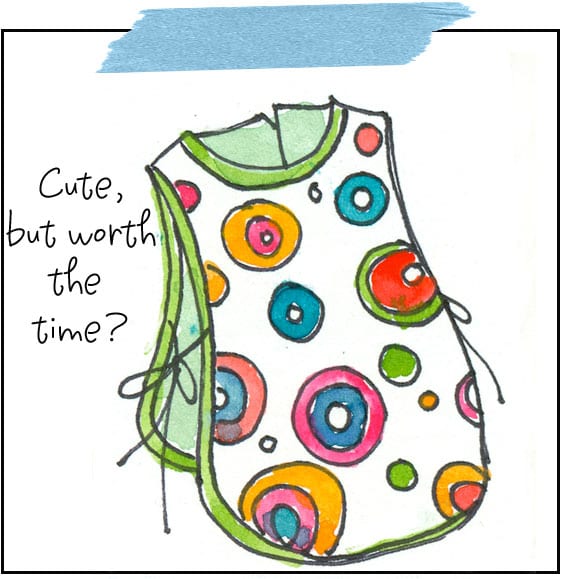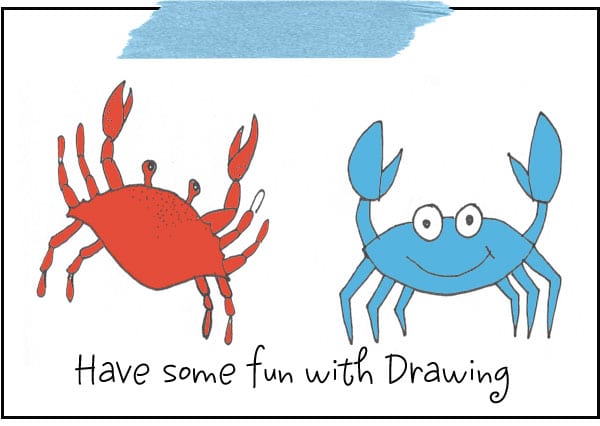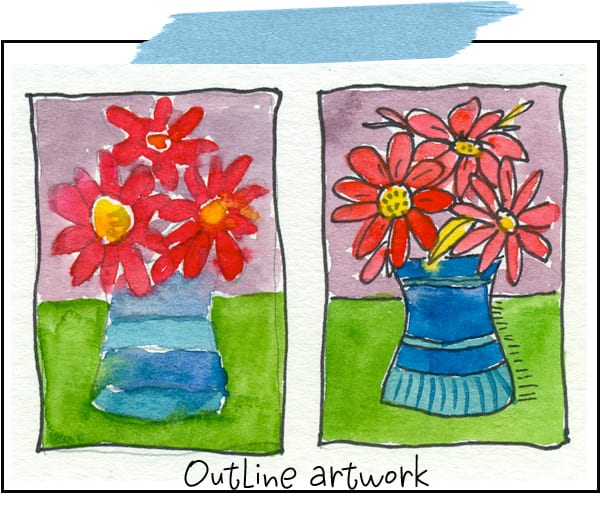Drawing of My Art Teacher
I love teaching art to children. My philosophy is quite simple:To engage, inspire and teach art with age-appropriate techniques and subjects. I've only been teaching art to children for eight years but it feels like I've been teaching my whole life. I remember what I was attracted to as an artistic child: how-to-draw books, colorful illustrations and art supplies (especially the jumbo pack of Crayola Crayons with the built-in sharpener). I keep these things in mind when I'm front and center amongst thirty kids. Over the years, I have tried many techniques and found some more effective than others.

Here is my list of top eight tips for teaching art to children:
#1 Ban pencils and erasers.
Sounds harsh, right? I rarely use pencils and erasers in my classrooms with the exception of a few lessons for upper grades. The reason is purely practical: small pencil leads encourage small drawings. If a kinder is drawing a portrait and then is required to paint that very portrait, using a pencil will surely lead to frustration. It's hard to paint tiny eyes! There is another reason: pencil markings can be erased, which leads to second guessing, which leads to lots of eraser action, which leads to class being over before the child has anything on his paper. Using oil pastels and/or markers allows the artist to move quickly, commit to the drawing and forgive their "mistakes". This is a big part of art for me; giving into the process and not worrying about the details.
#2 Mix paint onto paper, and not in paint palettes.
 Give a child paint and an individual palette and they can spend hours mixing paints to find the perfect color. If you have all the time in the world, then by all means do so! But if you are in a classroom setting, with 30 kids and a short amount of time, encourage the children to mix paints on their paper. Use the double-loading technique when you can. It produces very cool results and clean-up is much easier!
Give a child paint and an individual palette and they can spend hours mixing paints to find the perfect color. If you have all the time in the world, then by all means do so! But if you are in a classroom setting, with 30 kids and a short amount of time, encourage the children to mix paints on their paper. Use the double-loading technique when you can. It produces very cool results and clean-up is much easier!
#3 Forgo art smocks and aprons
 Gathering art smocks, getting them on, storing them, organizing them, etc. takes time. Sometimes by the time the children get their smocks on and get seated, 5-7 minutes of a 30-minute art class is gone. Get 'em in, get 'em settled and begin the fun stuff. I swear by Oxiclean, too. A good soaking in this powerful stuff can wipe out most stains.
Gathering art smocks, getting them on, storing them, organizing them, etc. takes time. Sometimes by the time the children get their smocks on and get seated, 5-7 minutes of a 30-minute art class is gone. Get 'em in, get 'em settled and begin the fun stuff. I swear by Oxiclean, too. A good soaking in this powerful stuff can wipe out most stains.
#4 The ten-minute quiet time
After instructions are given, the paper handed out and the children are engaged in their project, begin a ten-minute quiet time. This is their time; the chance to reflect on their work, the opportunity to lose themselves in their art, and perhaps the most important of all, the permission notto speak to their best friend. This quiet-time method only works if there is no transition involved. If the children are on day 3 of a project, I can expect that they will finish up at different times. Helping them transition to a new project or free-choice activity is not going to work during quiet-time.
#5 Learn how to draw well and make mistakes
 This is a fun one. I love to draw and demonstrating simple drawings for my students really helps them engage with the lesson when teaching art. I give lots of examples so if we are doing a lesson on chameleons, I draw a few different ones; some realistic, some silly, some animated. In the process of drawing on the white board, I always incorporate mistakes. Always. I laugh at my "mistakes", tell the kids to expect them and then I show them how to turn mistakes into something else. I include many how-to-draw sheets in my PDF art lesson plan booklets. These are mostly for the teachers (not necessarily for the kids). I think it's critical that you show your artistic side, no matter what you think of it, and inspire yourstudents. You can do it!
This is a fun one. I love to draw and demonstrating simple drawings for my students really helps them engage with the lesson when teaching art. I give lots of examples so if we are doing a lesson on chameleons, I draw a few different ones; some realistic, some silly, some animated. In the process of drawing on the white board, I always incorporate mistakes. Always. I laugh at my "mistakes", tell the kids to expect them and then I show them how to turn mistakes into something else. I include many how-to-draw sheets in my PDF art lesson plan booklets. These are mostly for the teachers (not necessarily for the kids). I think it's critical that you show your artistic side, no matter what you think of it, and inspire yourstudents. You can do it!
#6 Pick fun subjects
You probably know this by now, but I think its imperative that you chose the subject of your art lessons carefully. I want my students charging into the art room anticipating a fun lesson and bearing a can-do attitude. I love watching their faces as they look at my white board to catch a glimpse of the next art lesson. Often, kids will smile and say, "Oh, that looks hard!" but I know from their expressions that they know they will be able to do it. They have confidence! And if they have that, you have an eager and engaged crowd.
#7 Use 1/2 sheets to save time
I use the standard 12″ x 18″ drawing paper for most projects but if you cut that paper in half, children can complete the project in much less time. Not only does it save time, but it saves on supplies as well. All my projects can be done on smaller sheets, so don't feel by using a smaller paper size you are compromising.
#8 Outline, outline, outline
 The trick to making an art project look completed is to teach how to outline and add contrast to children. I've talked about outlining before and it's because it really makes the art pop. Think of how often Matisse outlined his work. If you are doing a drawing in pencil and then decide to paint with watercolors, it's really hard to keep the contrast unless there is a dark line in there somewhere. Use a sharpie waterproof black marker, oil pastel or even black paint and a small brush. It really makes a difference. And it doesn't always have to be black…try a blue or even a red. Cool.
The trick to making an art project look completed is to teach how to outline and add contrast to children. I've talked about outlining before and it's because it really makes the art pop. Think of how often Matisse outlined his work. If you are doing a drawing in pencil and then decide to paint with watercolors, it's really hard to keep the contrast unless there is a dark line in there somewhere. Use a sharpie waterproof black marker, oil pastel or even black paint and a small brush. It really makes a difference. And it doesn't always have to be black…try a blue or even a red. Cool.
Now, it's your turn…what are your best tried and true tips?
Download our free management, set-up, drawing & painting guide, to help you when teaching art from your home!
Source: https://www.deepspacesparkle.com/top-eight-tips-for-teaching-art-to-children/
0 Response to "Drawing of My Art Teacher"
Post a Comment